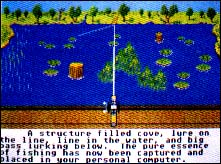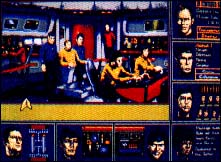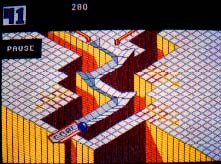FOR THE FUN OF IT
Tracker, Gone Fish'n, Star Trek
and Marble Madness
By David Plotkin
Summer.
The sun is hot, glowing gold, and you're probably thinking more of softball and soaking up some vitamin D rather than sitting indoors at your computer. But too much sun isn't good for you, you have to do something with your nights, and summer's the time for fun. And computer fun means computer games.
This issue we'll take a look at some games with outstanding graphics--although nice graphics don't necessarily guarantee good gameplay, as you'll see. For this issue we have a space adventure, an Earth-based simulation, an action-packed first-person game and, sigh, a not-great version of an arcade classic.
TRACKER
Tracker is a unique strategy/arcade game from Rainbird, the company that brought you Starglider, and the heritage shows. In Tracker, the heroine of Starglider journeys to the planet Egron to compete in the deadly game of "Tracker." Syndicated on the Egron networks, Tracker's advertising revenues are used to finance the war effort against the Novenia. And by the way, nobody has ever survived "Tracker."
Each contestant receives six skimmers, each equipped with shields and weapons. Your mission is to destroy the huge computer called "Centrepoint," which lies at the center of a vast network of intersecting tracks. The network is split into seven hexagonal sections, with communications links joining them and a communication center in each section. You must fly your skimmers through the network, destroying both attacking enemy ships and the communications links. If you destroy the latter, you can obtain the Quark bomb necessary to destroy a communication center. Destroy this and you'll get a Neutron bomb, the only weapon effective against the Centrepoint computer
Tracker is divided into two main sections. The first is the arcade sequence, where you search and destroy everything--the enemy ships, and communications links and centers. When an enemy approaches, an alert sounds, and you begin your attack, aiming with your mouse cursor and firing with the left mouse button. You also control your flight with the mouse, changing your velocity by moving the mouse pointer up and down while holding down the right mouse button. It's tricky navigating the winding trackways, especially at high speed, so it's best to zip down a track and let the autopilot get you to the next intersection. At the intersections are "nodes," the only places you can change direction.
| |
| Tracker, Firebird Licensees' strategy/arcade game. In Tracker you must destroy the huge Centrepoint computer. |
Strategy plays an important part in Tracker's second major section. The network of tracks is huge, and a straight-in approach to Centrepoint will just get you overwhelmed by enemy craft. Read the novella that comes with the game carefully for hints on how to win, and use your superior speed to outrun your enemies instead of slugging it out.
Tracker is completely mouse-driven, and its controls are easy to learn, with onscreen buttons to control all your actions. You may have all six of your skimmers moving at once, although this isn't wise; several might be attacked simultaneously, and it's almost impossible to defend yourself under these circumstances. I recommend just controlling one skimmer and leaving the others in "safe" zones until you need them.
The game has other nifty features, such as long- and short-range scanners that show the track network. Clicking on the "combat" button replaces the long range-scan with a 3-D, out-the-cockpit view, which you use when you're battling an enemy, flying down tracks or changing directions. Tracker's ability to load and save games also is welcome, since a complete game can take quite a while to play.
Tracker combines excellent simulated 3-D, action and strategy into an enjoyable contest. You must be willing to invest some time to play a good game, and be prepared to lose several games before you discover how to destroy Centrepoint.
GONE FISH'N
Gone Fish'n is--no joke--a bass fishing simulation. It's also one of those headscratchers that makes you ask, "Why was this put on a computer?" After all, real fishing means sitting in a canoe, slapping at deerflies, snapping turtles chomping your bait, getting roasted by the sun. Sort of tough to duplicate on a computer.
Well, it can't beat the real thing, but Gone Fish'n is actually a pretty fun game.
You play it in stages. Your first screen is the weather report, where you see the coming forecast: sunny, cloudy, or raining, the predicted fishing opportunities (good, fair, or poor), and temperature trends for each day of the current week. You may choose to fish or work on a particular day; each day you fish and skip work costs you money (as in real life!) You may also check the fishing tournament results for the previous week, and even enter a three-day tournament to win prize money.
 |
| Gone Fish'n, a bass-fishing simulation from Interstel. It can't beat the real thing, but it's a pretty fun game. |
Once you've selected your fishing days, you appear in your kitchen the morning of your first fishing day. From here you may tune in an accurate weather report for that day, check the map to see the eight fishing lakes in the area, call the lake to get a fishing report and check your game status. To fish at a particular lake, you must have enough money to pay the boat rental fees unless you own a boat. You may also choose to visit the tackle shop, where you can pick up lures, tools or even a boat, if you have enough money. The tackle shop has a variety of lures, all thoroughly explained in the manual.
Once you arrive at the lake, you climb in the boat and motor out to where you want to fish. Guiding the boat is a little tricky since you use the mouse to control speed and direction. Your boat has two motors: the gasoline one is noisy and fast, but your electric trolling motor is quiet--use it as you near your fishing spot. Then, drop anchor, put a lure on your hook and cast your line. You can reel your line back in slow or fast; a side view of your line shows how deep your lure is running and fish as they come in for a strike. As a fish strikes, set your hook by holding down the right button and jerking the mouse back at exactly the right time, then either reel the fish in (small fish) or play it to tire it out (big fish). If the fish is big enough, it may run for quite a while, and you'll hear your line being pulled out of the reel. The methods of playing and reeling in a fish are a little tricky, but well explained in the manual. Periodically you can check your Live Well (the cooler where you keep your fish) to see your progress.
At the end of the day you go home. If you have fishing days left that week, the next screen will put you back in your kitchen at the start of the next fishing day. If that's it for the week, you can choose when you want to fish the following week.
Gone Fish'n's graphics are good (the shoreline view changes depending on which direction you cast) although somewhat static. Sound is almost nonexistent, save for an occasional mosquito or bird. The manual is fine, although it never explained the term "pumping it in." The second half of the manual has some fishing background that has little to do with the game but it does make for enjoyable reading. I'm not sure why this game was put on the computer, but it's fun to play and easy to learn.
STAR TREK: THE REBEL UNIVERSE
Star Trek: The Rebel Universe is Simon and Schuster's first piece of ST software, and it's a winner.
 |
| Star Trek: The Rebel Universe. Based on the original series, this role-playing game lets you battle the Klingons. |
Star Trek: The Rebel Universe (here-after Trek) is a role-playing game that uses the settings and characters of the original "Trek" series. All the familiar faces are there--Kirk, Spock, Sulu, Chekhov, Scotty, McCoy and Uhuru. Your mission is to enter an area of space known as the "Quarantine Zone," where Klingons have been taking over Federation planets and starships with a "psimitter," a mind control device. The Enterprise is immune from its influence, but you'll still have to figure out how to disable the device and thwart the Klingon plot.
All of the Enterprise's controls are available through the bridge crew. Each person on the bridge has separate responsibilities, and you can call up any person by clicking on him or her with the mouse pointer. If you want something analyzed, click on Spock; for ship navigation, select Sulu; and for weapons, select Chekhov. Clicking on some of the bridge crew brings up several different screens, each of which you can select with the mouse. If this sounds complicated, it isn't: the controls are actually easy to master and very intuitive.
To complete your mission successfully, you must navigate the Enterprise through the area of space that's fallen to the Klingons. Navigation takes some practice, since you must choose which magnification of space you want to use in the navigation globe (some solar systems are not visible unless you choose a highly magnified view). Once you get the hang of it, set your course and speed and warp on over. A different screen controls which planet to go to after you arrive at a particular solar system.
Another fairly complicated function to master is weapons control. One screen lets you select phaser banks, the other selects photon torpedoes. You must then switch screens to choose a target, switch screens again to lock onto the enemy, then fire and hope for a hit!
There are many different planets in this game, most of which contain objects necessary for you to complete your mission. As you encounter these objects, keep track of where you found them and what they turn out to be useful for. Stay away from Klingon solar systems until you've located some objects to help you, especially repair facilities (this Enterprise doesn't seem to have any shields!).
If a planet can support human life, you may beam down a landing party. At this point, Trek becomes more like a conventional adventure game. Your landing party will encounter obstacles they must deal with, and you must choose from the suggestions of the captain and any crewmembers in the landing party on how to deal with those obstacles. Choose wrong and you may end up as one of the injured. If you fail to bring along the crew member whose suggestion will work, you may need to beam back up to the Enterprise, get him or her, then beam back down again.
Trek's sound and graphics are very good; the crew members are well-rendered and the digitized sound lends an air of realism. Trek's best trait is that it gives you many different ways to win. Once you've figured out how to achieve one of the goals, you can try to win the game a different way. The ability to load and save games (eight on each disk) also is handy, since it can take quite a long time to play a complete game.
The manual is also very good, detailing instructions, hints, a list of items you might find and what they are good for, and the ways of winning. There are even photographs from the original TV series and a description of beaming down to a planet to pick up something very useful. If you're tired of earthbound role-playing games, then I highly recommend Star Trek: The Rebel Universe to you.
 |
| Marble Madness, Electronic Arts' rendition of the coin-op classic. Unfortunately, the ST version doesn't live up to its potential. |
MARBLE MADNESS
Marble Madness for the ST should have been very good--the Amiga version certainly is. But something was lost in the translation to the Atari ST, and the result is a disappointing game which is frustrating to play.
In Marble Madness, you control a marble that rolls down a series of colorful "tracks" or paths, while trying to avoid animated obstacles, waves, troughs and other features designed to make "marble driving" difficult. The object is to control the marble from the starting point to the ending point of each course, and not fall off the paths. If you let the marble roll off the edge, you waste precious time, which is the real enemy in this game. When the time's up, the game is over. You may use the mouse or joystick to control the marble.
My biggest complaint with Marble Madness is that its controls are extremely difficult to master. I simply couldn't get acceptable control over the marble's motions--it seemed sluggish and unresponsive, no matter if I used a joystick or mouse. Further, the marble often hung over what appeared to be empty space without falling--an additional frustration. With perseverance, I could finally manhandle the marble with some degree of control, and I did see some of the upper screens. But it was a lot of effort to control the marble--too, much, I'm afraid, to recommend the game Pity.
Dave Plotkin is a chemical engineer with Chevron U.S.A., and is a frequent contributor to START and Antic.
PRODUCTS MENTIONED
Tracker, $19.95. Firebird Licensees, distributed by Activision, 2350 Bayshore Parkway, Mountain View, CA 94039, (415) 960-0410.
Gone Fish'n, $39.95. Interstel, distributed by Electronic Arts, 2755 Campus Drive, San Mateo, CA 94403, (415) 571-7171.
Star Trek: The Rebel Universe, $39.95. Simon and Schuster, distributed by Microservice, 200 Old Tappan Rd., Old Tappan, NJ 07675, (800) 624-0023.
Marble Madness, $34.95. Electronic Arts, 2755 Campus Drive, San Mateo, CA 94403, (415) 571-7171.